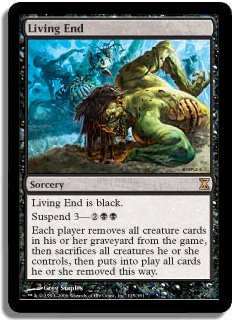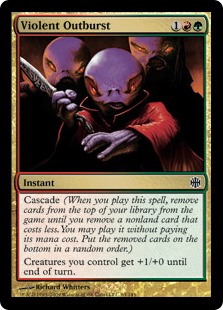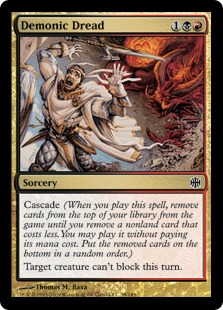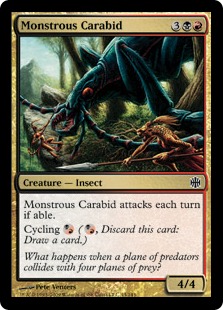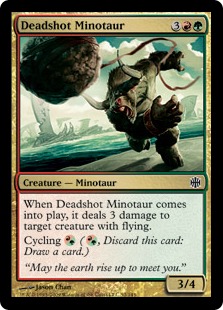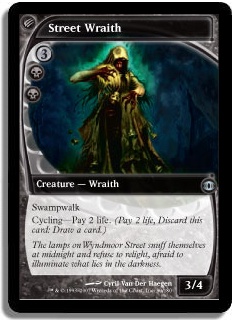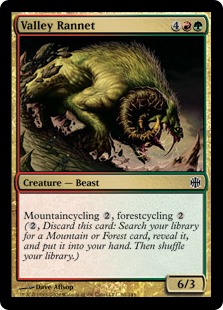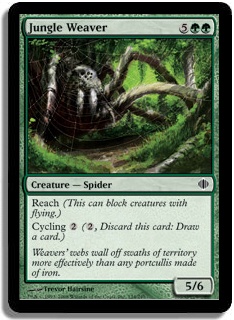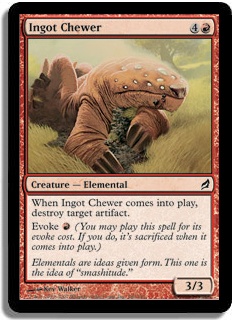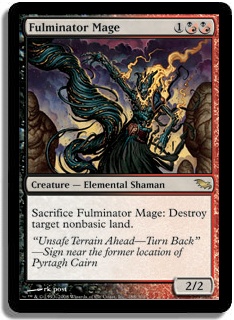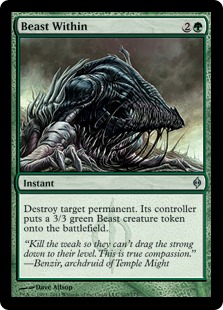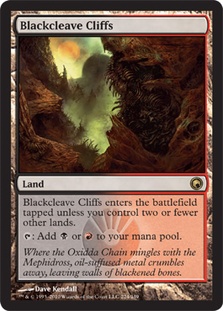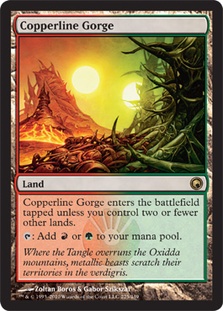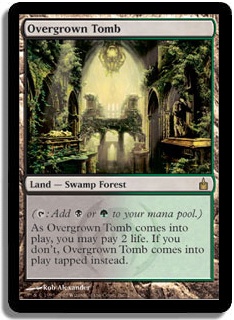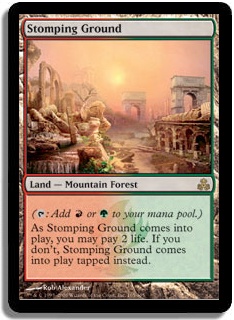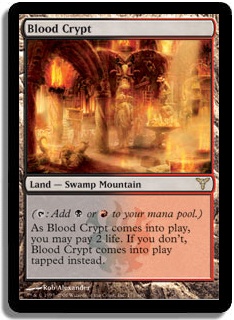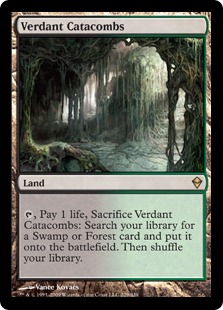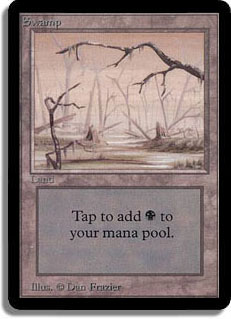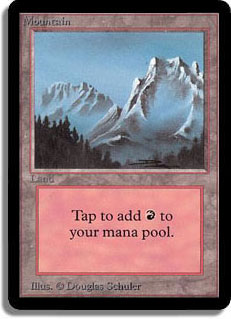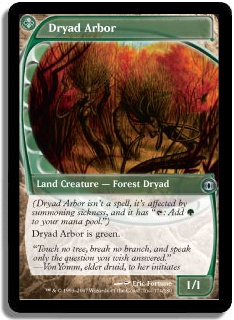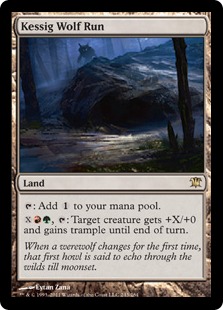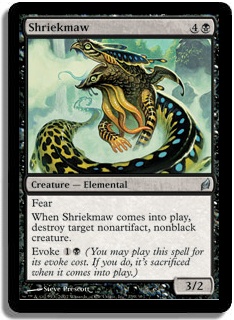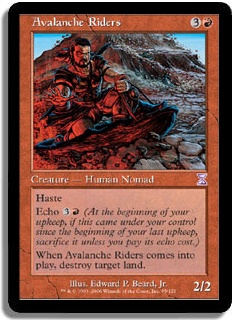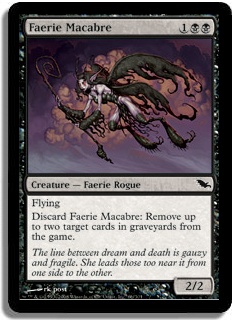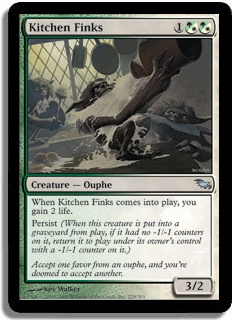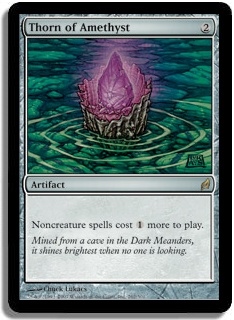Ari Lax did a fantastic job of analyzing the Modern metagame in this article earlier this week. He tends to always do a fantastic job bringing people up to speed on a format right before a large event happens. You could call it his specialty.
If you haven’t read the article yet or don’t have Premium, he does a great job reviewing the primary threats, secondary threats, the non-issues, and potential villains of the format.
But within his expert analysis, he forgot one card…
Which means he forgot one deck:
Creatures (27)
- 4 Street Wraith
- 4 Ingot Chewer
- 4 Fulminator Mage
- 3 Jungle Weaver
- 4 Monstrous Carabid
- 4 Valley Rannet
- 4 Deadshot Minotaur
Lands (19)
Spells (14)
Sideboard

How the Deck Works
3 Living End
The namesake card of the deck, Living End returns all the cards we cycled back to play to kill our opponent. It’s rather convenient that you spend the first few turns of the game cycling through your deck to find Living End, just to return said cycled cards back to play. It’s almost like they were meant to be together…
Keep in mind that suspending Living End is never out of the question. Yes, you’d like to be casting Living End primarily through the next eight cards I’m going to review, but suspending drawn copies is an avenue to victory that happens more often than you’d think (especially against blue based control decks).
4 Violent Outburst
The first of two ways to cheat Living End onto the stack, Violent Outburst is the better of our two cascade spells for a few reasons:
- Instant. This allows you to go off at any time you see fit. Even the threat of leaving up 1GR will cause your opponent to play differently. And if you don’t have it? Keep on cycling until you do!
- +1/+0. A lot of people forget that you don’t have to cast the card you cascade into. You can use Violent Outburst as a way to buff your team for one alpha strike.
4 Demonic Dread
Slightly worse than Violent Outburst due to its sorcery status, Demonic Dread still provides one major advantage that Violent Outburst doesn’t:
Target creature cannot block. There are times when you’ll be racing your opponent or won’t be able to get through a large Tarmogoyf / Wurmcoil Engine. For those times, Demonic Dread is your best friend in the entire world.
Our Threats
4 Monstrous Carabid
One-mana cyclers are crucial to our game plan, and this is the best one available in our colors due to its size. When the games begin to get grindy and you have to start hard casting your threats, a 4/4 even at five mana is often the largest threat on the table. And its drawback? It’s hard to say there is one since attacking is what you want to be doing once all your creatures are in play anyway!
4 Deadshot Minotaur
The second best one-mana cycler available in our colors, Deadshot Minotaur isn’t as big as Monstrous Carabid, but it trades that one power for the ability to potentially shoot down a flyer. When you get into the games where you have to hard cast your threats, you’ll be glad you have the option to shoot down an Insectile Aberration or two.
4 Street Wraith
A common misconception about Street Wraith is that it cycles for free, but in a format full of Lightning Bolts, Insectile Aberrations, Bloodbraid Elves, Vexing Devils and large Grapeshots, two life is often the difference between a win and a loss. It’s clear that Street Wraith is a natural fit for this deck because its cycling cost is so mana efficient, but selecting the right time to cycle this 3/4 Swampwalker is an art form in and of itself.
4 Valley Rannet
Mr. Wonderful! Valley Rannet does so many things for our deck that you’ll be hard pressed to find a better card throughout the 75:
- Allows us to run a lower land count than what is normally acceptable.
- Can find basics or Ravnica dual lands in a pinch.
- Can search out Dryad Arbor in the games where you need to produce a Demonic Dread target.
- Has six power, which allows us to kill our opponent much faster than normal.
Mr. Wonderful does have his drawbacks of course. Cycling for two mana instead of one is a big difference and three toughness isn’t ideal in a world full of Lightning Bolts and Kitchen Finks, but those are the sacrifices you have to be willing to make in order to get the positives Valley Rannet provides.
3 Jungle Weaver
The best of the other two-mana cycles available, Jungle Weaver provides a body large enough to tangle with Tarmogoyf. It’s also extremely important against decks that contain fliers, like Affinity (Vault Skirge, Blinkmoth Nexus, Inkmoth Nexus, Signal Pest) and U/W/R Delver (Insectile Aberration, Geist of Saint Traft Angel token).
The Utility
4 Ingot Chewer
In a world full of powerful artifacts, you need a way to get a leg up on your competition, and Ingot Chewer is the best way to accomplish that. The list of problems that Ingot Chewer solves is long—Relic of Progenitus, Tormod’s Crypt, Nihil Spellbomb, Azorius Signet ,and Aether Vial just to name a few—but what makes it so great in this deck is how favorably the evoke mechanic interacts with Living End.
When playing against graveyard hate artifacts, there is no better card you can have than Ingot Chewer, but make sure you stack the evoke trigger and comes-into-battlefield trigger correctly. I wouldn’t want your Ingot Chewer getting exiled from the game due to sloppy mechanics.
4 Fulminator Mage
If you’ve played even a tiny bit of Modern, you know how reliant each deck is on their non-basic lands. Some decks are built around them entirely like G/R Tron, while others use them to cast a bevy of colored spells like Zoo and Naya Pod. Whatever the case may be, each deck in Modern outside of Burn primarily uses non-basics to their advantage, and Fulminator Mage gives us a way to punish them for that. Best of all, Fulminator Mage plays incredibly well with Living End. What more could you ask for?!
3 Beast Within
This is your catchall card. Beast Within is able to take care of any threat, both expected and unexpected. There are matchups where Beast Within truly shines—blowing up an Urzatron piece for example—and matchups where no other card could save you, such as playing against someone with maindeck Leyline of the Void. It provides all of this utility at a reasonable cost, but with the drawback of giving your opponent a 3/3…
That conveniently dies to Living End while all of your creatures come back.
So how do we cast our spells?
The Mana Base
2 Blackcleave Cliffs and 2 Copperline Gorge
You’re probably quite familiar with the Scars lands by now, but they play an important role in Living End. Because you don’t expect your games to go incredibly long, these four lands provide painless color fixing, and their drawback is rather irrelevant because you only need three lands to operate. Â
1 Overgrown Tomb, 1 Stomping Ground, and 1 Blood Crypt
The reason we play a few Ravnica dual lands is because they can be searched for via Verdant Catacombs and Valley Rannet. You don’t want to play a bunch of them because you can’t afford to deal yourself a lot of damage, but you play just enough because the fixing they provide is invaluable.
4 Verdant Catacombs
The only on-color fetch land this deck has access to, Verdant Catacombs allows us to search out our basics in case of Blood Moon, our Ravnica Dual lands in case we need fixing, and our Dryad Arbor in case we need to produce our own target for Demonic Dread.
2 Forests, 2 Swamps, and 2 Mountains
They can’t all be non-basic now can they?!
1 Dryad Arbor
With Green Sun’s Zenith being banned, there aren’t a lot of homes for Dryad Arbor in Modern, but Living End is certainly one of them. Its biggest positive is that it allows for you to provide a creature to Demonic Dread to cascade into Living End when your opponent hasn’t done that for you. It’s also been known to surprise block a creature through a Verdant Catacombs or be the home of a large activation of the next card on my list.
1 Kessig Wolf Run
Between all of the natural cycling, Valley Rannet land cycling, dual lands, and Verdant Catacombs, Living End has a very stable mana base. Because of that, it is able to play one colorless land that can affect the game. There are a lot of options for what card could fill this slot—Svogthos, the Restless Tomb for example—but I’ve found Kessig Wolf Run to be the most high impact of what’s available. The main reason for that is because it lets your smaller creatures trade with a large Tarmogoyf, but the trample Kessig Wolf Run grants has been relevant on more than one occasion as well.  Â
My Current Sideboard
3 Shriekmaw
We’ve already gone over how well evoke and Living End interact, so Shriekmaw shouldn’t come as much of a surprise. The reason you’ll find Shriekmaw in the sideboard is because when it’s good, it’s very good—killing Thalia, Guardian of Thraben, Tarmogoyf, Delver of Secrets / Insectile Aberration, Kird Ape, etc.—and when it’s bad, it’s very bad.
3 Avalanche Riders
Your matchup against Urzatron decks is fairly good because of Fulminator Mage (kills almost every land in both Tron decks) and Ingot Chewer (blows up Signets and Expedition Map) but could use a little more to put it over the top.
Avalanche Riders is the card that helps to put it over the top.
Not only is blowing up more Urzatron pieces a good thing, but echo is another mechanic that plays favorable with Living End. I also like to bring in Avalanche Riders on the play against Jund decks. While Jund has a very good mana base, it is a mana base that does not like to be tampered with (think of the Spreading Seas days). Fulminator Mage, Avalanche Riders, and Beast Within are great ways to disrupt the mana base of Jund while you’re searching for that way to cheat all of your creatures into play.
3 Faerie Macabre
Now this is one of my favorite cards throughout the entire 75 because it has so many applications:
- Against U/W Tron, their goal against you is to cast Gifts Ungiven for a large threat (typically Iona, Shield of Emeria, but Elesh Norn, Grand Cenobite works well too) and Unburial Rites. Faerie Macabre is an uncounterable way to stop that.
- Against Melira Pod, Faerie Macabre is able to break up their combo by removing their persist creature (Kitchen Finks or Murderous Redcap) from the game before the persist trigger resolves.
- Against the Goryo’s Vengeance decks that are popping up, Faerie Macabre is the ultimate trump.
- Shrinks a Tarmogoyf.
- Trumps a Snapcaster Mage.
- Slows down Storm by removing cards for Pyromancer Ascension / Past in Flames in addition to making Faithless Looting a relatively fair card instead of a broken one.
And on top of all of that—I’m sure there are some interactions that I forgot—I didn’t even mention that Faerie Macabre comes back from the graveyard when you cast Living End!
3 Kitchen Finks
Against the aggressive decks of the format, Shriekmaw simply isn’t enough to stop their initial pushes. Sometimes you need a little help buying time until you can resolve a Living End to clear their board. Kitchen Finks is the best to go about doing that because it gets to block twice, gain us four life, and it, like everything else in our deck, works extremely favorably with Living End.
3 Thorn of Amethyst
This one may throw you for a loop, so bear with me while I explain what’s going on. Combo decks based around Shivan Reef (Storm, Hive Mind, Dragonstorm, etc.) are far and away our worst matchups. Our combo is mostly irrelevant against them, our clock isn’t quite fast enough, and our disruption of Fulminator Mage and Beast Within isn’t very effective because they use Rituals to generate their mana instead of their lands like Urzatron decks do.
Thorn of Amethyst provides us the time to make our disruption relevant and our clock fast enough because while they’re stumbling around trying to assemble enough Rituals and lands to go off, we’re messing with their resources via Fulminator Mage, Beast Within, and Avalanche Riders. Keep in mind this plan only works because those combo decks cheat on their mana so they can play a high density of spells and cantrips. It’s part of the appeal to playing those types of decks. So what we’re doing is taking one of their greatest strengths and using it against them!
When using this plan against them, this is a rough idea of how you sideboard:
-3 Living End, -4 Demonic Dread
+3 Thorn of Amethyst, + 3 Avalanche Riders, +1 X
What if I don’t like your sideboard?
No offense taken. The cool thing about Living End is that its sideboard is highly adaptable. Below are just a few of the options at your disposal:
- Spitebellows. Comes back with Living End and kills the annoying hate bears like Thalia, Guarding of Thraben and Ethersworn Canonist.
- Dismember. Its converted mana cost is three mana, so you won’t cascade into it. It’s a nice way to answer hate bears, but the four life you pay is no joke.
- Brindle Boar. Easier on the mana and better against Burn than Kitchen Finks, but worse in matchups where you may want to grind them out (i.e., the mirror, Jund, etc.).
- Night of Soul’s Betrayal. Tops the Splinter Twin combo dead in its tracks if you can get to four mana in time.
- Volcanic Fallout. Really good against Combo Elves and U/W/R Delver (kills Steppe Lynx, Delver of Secrets / Insectile Aberration, Geist of Saint Traft, and Snapcaster Mage), but is a little difficult on the mana and the two damage it deals to you is oftentimes relevant.
- Jund Charm. Plays the same role as Volcanic Fallout in most cases, but has the added utility of clearing a graveyard against those type of decks (i.e., Storm decks),
- Leyline of the Void. If you’re expecting the mirror (which you shouldn’t be).
- Hammerheim Deadeye. Kills Iona, Shield of Emeria dead because there is no way in hell they are naming red against you.
- Maelstrom Pulse. A nice catchall if you want more of that type of thing.
- Blood Moon. If the format calls for it, you certainly have access to it and enough ways to search out basics (Verdant Catacombs and Valley Rannet) to make it irrelevant.
Why should you play this in Columbus?
If you don’t think you’re smart enough to play the Birthing Pod decks correctly, don’t like the variance of the Tron decks, and have no interest in playing Delver of Secrets at another tournament, Living End is a great choice for the weekend. What makes Living End unique is that it has a ton of very good matchups (Naya Pod, Splinter Twin, Jund, Tron decks, Zoo) and a few unwinnable matchups (Storm, Burn, Mono-Blue Faeries). Much like Charbelcher in Legacy, if you get the right matchups during the tournament, you could very easily be playing in the Top 8.
How about we look at some cool interactions in the deck?
I’ve got plenty of those for ya:
- Against Splinter Twin, if you leave up 1GR on any of your turns, they can never go off (assuming they’ve cut Remand like everyone else has). Violent Outburst cascading into Living End can’t be stopped because countering Violent Outburst doesn’t do anything and Dispel doesn’t work on Living End because Living End is a sorcery.
- Against Splinter Twin, one of the ways they actually can beat you is to kill you on the play by playing a turn 3 Deceiver Exarch / Pestermite and then a Splinter Twin on turn 4. The way for you to trump that is to board in your Shriekmaws so you have access to a two-mana removal spell.
- Against Affinity, it is rather important for you to find the time to cycle a Jungle Weaver. Typically they deal you around twelve points of damage in the opening turns, you cascade into Living End to get a few guys back, and they finish you off with a Vault Skirge, Signal Pest, or one of their many Nexuses. Jungle Weaver is your way to stop that from happening.
- Never board out Ingot Chewer. It’s impossible to predict what graveyard hate your opponent may have. In most cases, it is an artifact (Nihil Spellbomb, Relic of Progenitus, Tormod’s Crypt, Ethersworn Canonist), so you have to leave Ingot Chewer in at all times to mitigate that.
- You’ll notice that among that artifact hate that I didn’t list Grafdigger’s Cage. The reason I did that is because it is actually a blank piece of cardboard against you. Take the time to reread the card, then read Living End, and then hope your opponent boards it in against you at the Grand Prix so you can laugh in their face as you cascade into Living End anyway.
- Don’t be greedy. There are a lot of decks in Modern that can’t beat you returning a Monstrous Carabid and Valley Rannet back from the graveyard on turn 3. Setting up large Living Ends is awesome, but it isn’t always necessary.
- Against Tron decks, mulligan to some form of land destruction. Just because your deck is well set up to beat them (Ingot Chewer, Fulminator Mage, Avalanche Riders, and Beast Within) doesn’t mean you can afford to keep crappy hands. Their deck can be quite unforgiving.
- I’m not entirely sold on the Thorn of Amethyst plan being good. It’s something I’ve been testing online (if you watch my stream, you’d know that!) to some success. If you don’t feel comfortable trying to beat Storm that way and would rather just concede that matchup and shore up other matchups with those three sideboard slots, that is completely understandable.
- Naya Pod is what many believe is the best deck in the format. They have three ways of interacting with you right now: two Thalia, Guardian of Thraben and one Ethersworn Canonist. Shriekmaw, a card you would be boarding in anyway against their non-black deck, kills Thalia and Ingot Chewer kills Ethersworn Canonist. Also, Living End kills their entire deck!
- Decks that have sacrifice effects (Arcbound Ravager, Viscera Seer) are annoying to play against but not unwinnable. Part of the reason I started playing this deck in the first place last season was because Splinter Twin cut all of their Remands and Affinity cut all of their Arcbound Ravagers. If those things have stayed the same, that is good news for you.
- You can get yourself into situations with Ingot Chewer and Violent Outburst where you can evoke Ingot Chewer targeting whatever graveyard hate artifact they have in play, they’ll activate said graveyard artifact, and then you cast Violent Outburst in response to get all of your creatures back.
- Discard is rather poor against you. Thoughtseize and Inquisition of Kozilek do take your Violent Outbursts and Demonic Dreads, but your entire deck cycles so finding another one isn’t very difficult. Do not be fazed by decks with discard. Just be sure to cycle Street Wraith last against them.
- Practice, practice, practice! This deck is easy to play incorrectly. It isn’t the hardest deck in the world to play, but it has interactions that you’re probably not used to. Don’t play it, or any deck for that matter, without any practice.
Until next week!

